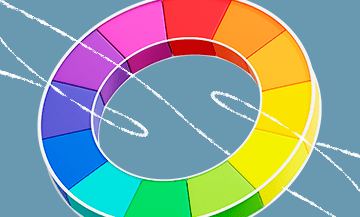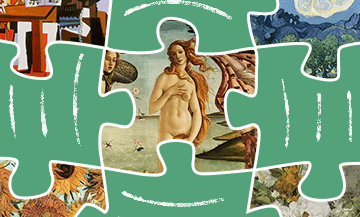Behind the scenes of creativity: who is an artist?
Many will say that professional artists necessarily study in art schools and painting academies. Although this statement is very popular, it is not entirely true.
In the history of painting, there are many self-taught artists who have gained recognition and become famous. This even led to the emergence of a new art direction — naive painting.
To become an artist, education is not always necessary. So, the question arises: who is an artist? Let’s find out!
Artists are people who create beautiful and unique art that can inspire, move, and change our lives.
Art does not always find its expression in diplomas and academic degrees. Perhaps a true artist is someone who sees beauty in every detail of life and knows how to share it with the world?
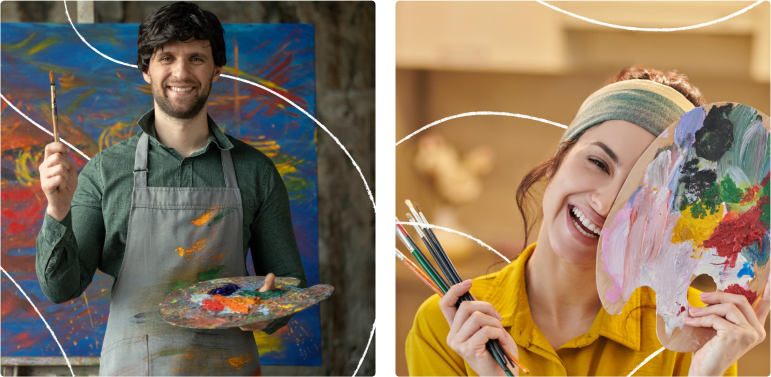
Profession artist: pros and cons
Artistry is undoubtedly one of the most unique and captivating professions in the world. An artist is a creative genius who immerses us in their world through painting — they convey their emotions and ideas. However, like any other profession, an artist can boast about the advantages of their work and warn about its disadvantages.
Pros:
- Creative freedom: artists are people who value personal freedom. This profession provides the opportunity to express oneself, create, and transform the world through creativity.
- Career opportunities: artists work in galleries and museums, freelance, or even open their own art studios. With the development of the Internet, modern artists can easily sell their works online and receive orders from all over the world.
- Unusual and unique work: being an artist means looking at the world differently, noticing beauty in simple everyday things. Artists create original artworks that influence people and their emotional states.
Cons:
- Income instability: however, despite all the advantages, artists often face income instability. Selling works is unpredictable, and earning enough to support oneself and one’s family can be challenging. If you are new to the art world and your name is not yet well-known — take this into account. The path of an artist is thorny and comes with its own trials.
- Criticism and misunderstanding: in the art world, you will encounter many different opinions and tastes, and every artist faces criticism. Some people do not understand or appreciate artistic creativity — be prepared for this as well. You will need constructive criticism, which you can receive from a painting teacher — for example, in my classes and workshops.
- Loneliness: artists spend a lot of time alone, immersed in their creativity. While drawing is a beneficial process for reflection and inspiration, you may encounter feelings of isolation and detachment from society.

For people who are truly passionate about art, the pros far outweigh some of the cons. Because, ultimately, being an artist is a gift and an opportunity to share one’s inner world with others.
Artist's talent or skill: what is more important in painting?
The eternal debate about what is the key element of success in painting — the artist’s talent or skill? Undoubtedly, both aspects are interconnected and play an important role in shaping the future creator.
Talent is the natural ability for creativity, the spark that ignites the source of inspiration. It gives the artist a special perspective on the world, the ability to see beauty and depth in ordinary things that others might simply overlook.
Talent is like an invisible magic that gives work originality and emotional power. It speaks the language of art, allowing the artist to express their thoughts, feelings, and ideas through brush and paint.
However, without skill, you will not become a professional artist. Skill encompasses deep knowledge and understanding of technique, composition, color, and light. It requires hard work, learning, and constant development.
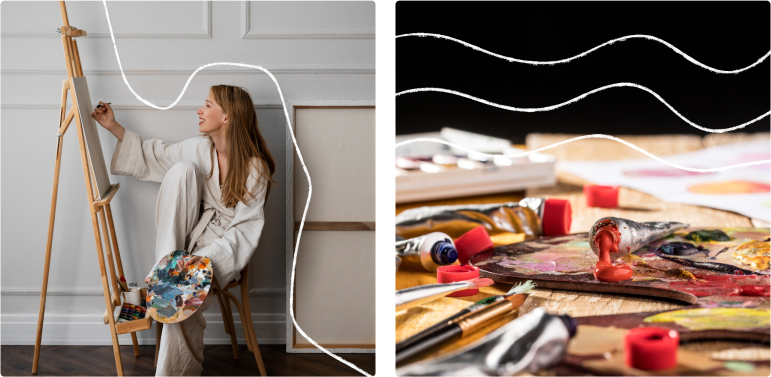
Skill generates confidence in one’s abilities and allows the artist to freely manipulate the form and structure of a work.
Talent and skill complement each other, creating the perfect combination for works of art that simultaneously captivate the imagination and impress with their technical and emotional depth.
An artist’s talent provides ideas and inspiration, while skill turns these ideas into vivid and beautiful paintings.
Masterpieces are born from geniuses endowed with all possible gifts: exceptional talent and unparalleled skill. Their paintings adorn prestigious galleries around the world, winning the hearts of art lovers. Therefore, it is impossible to prefer one (talent or skill) over the other.
Artist's Personality Qualities
An artist is a magician, but their magic is manifested not in spells, but in every brushstroke, in every note of color, in every thought transformed into a work of art. The qualities of this creator’s personality are like paints on their palette, creating a unique shade of their artistic soul.
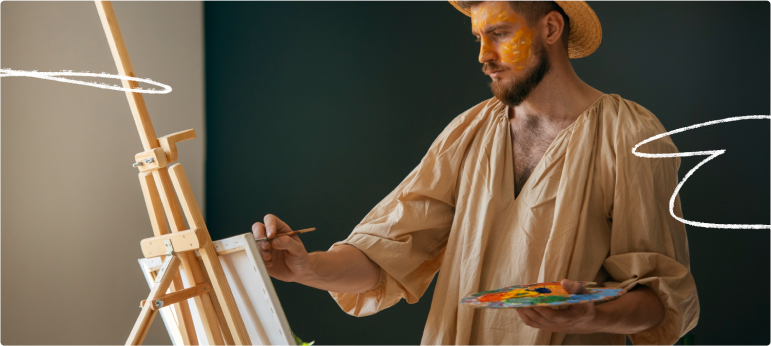
What qualities are indispensable for every artist?
- Imagination — allows the artist to see beauty in simple things, to penetrate the mysteries of the world, and to recreate their dreams on canvas. An artist with a good imagination can turn the ordinary into a work of art.
- Sense of observation — is a mirror reflecting the nuances of the world around. An artist, as a keen observer, notices details that escape the eye of the layperson. This sense gives them the ability to convey the finest nuances on canvas or in other forms of creativity.
- Striving for perfection — is the fire burning within the artist, driving them to constant improvement. They do not stop at what has been achieved but seek new forms of expression, new techniques, striving for the ideal, even knowing that the ideal is an endless pursuit.
- Empathy — is the key to creating works of art capable of touching the viewer’s heart. It is important to feel the pain and joy of others to transfer these emotions to their creations.
- Resilience — is the inner strength that allows the artist to overcome difficulties and, despite the currents of time and circumstances, to remain faithful to their creativity. Resilience is like a belief in one’s own artistic wings, allowing them to rise above possible heights.
An artist is a free spirit. They do not think about the size of the canvas or limited materials. They are not afraid to experiment and take risks to find the true depth of their talent. Thanks to their freedom of thought and creative imagination, an artist creates works of art that surprise and delight.
Freelance artist: life, creativity and earnings
Artists in modern society follow various paths to their career success. Some prefer to be employed in art institutions, while others, more adventurous in spirit, strive for the status of a freelance artist.
A freelance artist is someone who works independently of organizations or social structures. The main advantage of being a freelance artist is that the creator fully controls their creativity and can choose the style, direction, or theme of visual art that interests them.
The earnings of a freelance artist can come through several avenues. For example, through the sale of their own works. The artist independently promotes their paintings, sculptures, or graphic works through galleries, exhibitions, or online platforms. More successful and well-known artists may secure contracts for commissioned works.
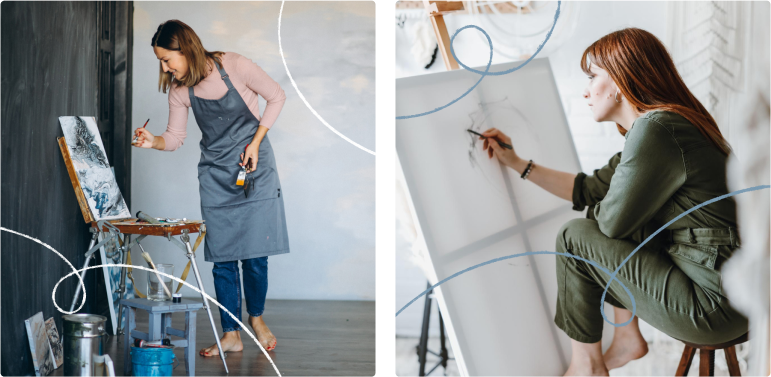
Another way for a freelance artist to earn money is through commercial projects. Many companies and businesses seek unique and original ideas for branding or advertising. An artist can offer their services for drawing logos, illustrations, interior decorations, and more.
However, despite all the advantages of being a freelance artist, the path to success is not always easy. Irregular and unstable income, lack of insurance, and other nuances become part of the daily reality of these creative souls.
Often, artists have to take on the roles of manager, marketer, and accountant simultaneously to ensure favorable conditions for themselves and their creativity.
Nevertheless, the freelance artist profession provides an opportunity for self-expression, creative development, and deep immersion in art. For many artists, this is the only path to happiness. There are countless stories of creative individuals becoming freelance artists, and each of these stories is unique…
Amateur and professional artist: personality traits

An artist is that enigmatic personality capable of penetrating the depths of our souls through their works and stirring our most intimate emotions.
A person passionate about creativity encounters two different stages on their path — amateur and professional. Two different worlds, two different views on art, two different energies.
An amateur artist is someone who finds true pleasure in creating works of art. This freedom of creation, unbound by rules and limitations, allows them to express their thoughts and emotions on canvas, in clay, or any other material. Bright colors, twisted brushes, paint-stained hands — all these are part of their inspiration and spontaneity.
However, with years and experience, the artist develops a desire for perfection, for conscious and professional work.
A professional artist hones their craft, studies techniques, genres, and art materials down to the smallest detail. Their works are “born” meticulously and thoughtfully, considering every dimension and composition. Every brushstroke and every hand movement has significance and purpose.
It’s fascinating to observe how an amateur artist becomes a professional while retaining that extraordinary perception of the world characteristic of an amateur. Perhaps, it is in this symbiosis that the essence of true art lies — the ability of a great master to remain a genuine child of their creativity.
Whether you are an amateur or a professional, an artist is a person with unique characteristics. They can see beauty where others look past.
The world is full of stories about talented and original artists, many of whom gained fame without formal art education.
For when art and inspiration commanded them to create, they did not stop.
One such unique master was Vincent van Gogh — a genius who revolutionized the concept of the art world. A self-taught painter and representative of Post-Impressionism, he was unique in his kind — with an inimitable style and skill.
We cannot forget the French artist Henri Rousseau, who initially worked as a customs officer before discovering his true passion for art. His still lifes and jungle landscapes vividly reflected his wild imagination and remarkable sense of color.
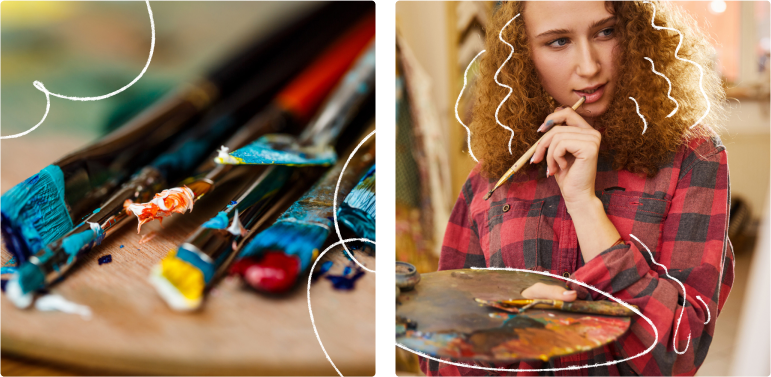
10 Tips for Beginning Artists
- Love the process: don’t rush into the details of the final result. Enjoy the moment of painting, be inspired by each brushstroke.
- Experiment with materials: don’t limit yourself to just pencils or paints. Try different materials and techniques to find your unique style.
- Don’t be afraid to make mistakes: mistakes are steps to mastery. Every wrong move can lead to an unexpectedly beautiful discovery.
- Study the art of others: be interested in the works of great masters and contemporary artists. Learn their techniques and then add your own character to them.
- Keep a creative journal: write down your ideas, dreams, and desires that you would like to realize on canvas. This way, you can track your creative process.
Create your own creative profile on Instagram. Note that many bloggers in the art field find clients specifically on Instagram. A good presentation of yourself on Instagram is an excellent way to promote your work commercially.
- Communicate with other artists: join interest groups, discuss your work, and get feedback. The community of creative people is always a source of inspiration.
- Pay attention to composition: experiment with the composition of your works. Sometimes, just changing the angle or arrangement of objects can breathe new creative life into you and work wonders.
- Develop creative thinking: train yourself to see the unusual in the ordinary. This opens the doors to an endless world of ideas.
- Set goals: determine what you want to achieve and gradually move towards it. Every small goal is a step forward.
- Don’t compare yourself to others: art is an individual creativity, and every artist has their own style and voice. Allow yourself to be unique and don’t try to copy the style of other creators.
Remember that art is a journey, and the most important thing is to enjoy every stage of it. May inspiration always be with you!
Almost all of the above tips will help you form your own individual style as a creator.
First of all, relax: live, try new things, rest, watch beautiful movies and read interesting books, don’t stop at what you’ve achieved — this way you will definitely be able to unlock your talents and become the artist you dream of. Simply put, find inspiration around you!
Question-answer
An artist is a person engaged in creative activity in the field of visual arts. They create works of art using various techniques and materials.
Artists typically express their thoughts, emotions, and vision of the world through their artworks, and their creations often become objects of admiration.
Artists specialize in various styles and genres, such as realism, impressionism, surrealism, abstract art, and many others.
Want to become an artist too? Ask yourself these questions:
- Am I genuinely passionate about art? Is it something I want to do every day?
- Do I have patience and persistence?
- Do I notice beauty in the world around me, details, colors?
- Am I ready to continuously learn, seek new techniques, and improve my skills?
- Do I feel a need for creativity and experimentation?
- Can I handle criticism?
The most important thing for an artist is creative vision and the ability to express their thoughts and emotions through art. An artist needs to train themselves in observation and perception of the world around them.
An artist should be open to new ideas, experiment with different techniques and materials, and strive for self-expression. It’s also important to have perseverance, patience, and diligence, as creators often spend a lot of time on a single project.
Finding sources of inspiration, developing creative ideas, and bringing something new to the world of art are crucial.
And, of course, no artist would refuse fame and recognition. Paintings should interact with society, evoke admiration, inspiration, and lively discussion.
- Basics of Visual Art: understanding the fundamentals of composition, perspective, light and shadow, color theory, and other basics of visual art.
- Technical Skills: mastery of various techniques such as drawing, painting, sculpture, graphics, and more. Technical skill helps in better expressing one’s ideas.
- Art History Knowledge: studying the history and evolution of art helps the artist understand the context of their work and be inspired by traditions and innovations.
- Experimentation: willingness to experiment and seek new approaches in creativity. Innovations can help the artist grow and stand out.
- Observation and Perception of the World: the artist should be a skilled observer, able to notice details and features of the surrounding world.
- Critical Thinking: ability to analyze one’s own work and the work of others, as well as to accept constructive criticism; these skills contribute to the growth and improvement of the artist’s art.
- Cultural Diversity: knowledge of different cultures, arts, and styles can enrich the creative process and broaden the artist’s horizons.
- Communication Skills: ability to effectively communicate about one’s art, explain ideas, and interact with the public, curators, and other artists.
- Financial Literacy: understanding aspects of the art market, promoting one’s work, and managing finances effectively in the context of an artistic career.
- Personal Development:ongoing learning and personal development, as art is always evolving, and a successful artist is ready for constant growth and change.
An artist is called to create on the canvas and reproduce the ineffable beauty of the surrounding world, turning the mundane into a wild symphony of colors and forms. For an artist, there are no forbidden themes or limitations; their inspiration is boundless.
They spend hours, even days, in their creative space, detaching from reality and immersing themselves in the world of their inner universe. The creator can see beauty in simple leaves, in the play of light on ancient buildings, in the faces of passersby on the streets. They view the world through the eyes of a romantic and the heart of a dreamer.
An artist creates works to convey not only their emotions and feelings but also to view the world through the lens of art. They bring canvases to life, making them “breathe” and vibrate.
An artist is not confined by the boundaries of genre or style; they paint and experiment, opening new horizons and reinterpreting the old. The creator can be a painter, sculptor, engraver, or a representative of contemporary art.
Thanks to the artist’s creativity, we marvel, reflect, and simply enjoy the beautiful.
- Preservation of cultural heritage: Artists create works that reflect and preserve the cultural heritage of peoples and eras. Thanks to their work, we can learn about past times, traditions, and values of various cultures.
- Expression and communication: Artists use art to express their thoughts, feelings, ideas, and perspectives on the world. They can be voices for those who do not have the opportunity to speak or be heard. Their works often convey emotions and messages, provoke discussion, and prompt reflection.
- Inspiration and aesthetic satisfaction: Artists’ paintings can inspire and evoke emotions and interest in people. They can provoke awe, joy, sadness, and affection, among other feelings. People enjoy experiencing aesthetic satisfaction. One can visit galleries or hang paintings at home.
- Brings economic benefit: Art and culture are important sectors of the economy. Artists’ work contributes to the development of cultural tourism, creates jobs in the arts and related fields, and promotes economic growth and the development of society as a whole.
- Development of critical thinking and creativity: Artists constantly explore and experiment. They find new.



